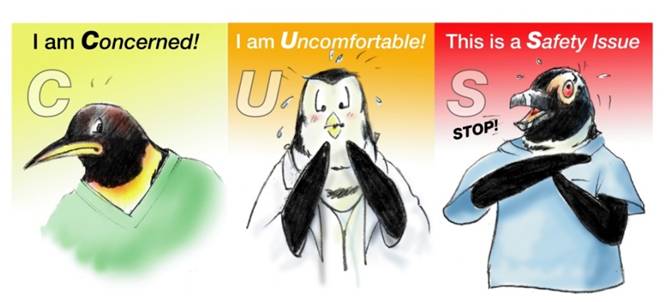

Conflict Resolution
All teams must exercise strategies for resolving informational or interpersonal conflict if they are to be truly effective and mutually supportive.
There are three tools for conflict resolution:
When dealing with conflicting information, or conflicting views of a problem:
1. Two Challenge Rule: Invoked when you believe information is incorrect or an assertion
is ignored or resisted…
- It is your responsibility to assertively voice your concern/corrective up to TWO TIMES
to ensure that it has been heard - The member being challenged must acknowledge
- If the outcome is still not acceptable, then you should:
- Take a stronger course of action
- Call upon a supervisor, or use the appropriate chain of command.
An Example:
Leader: "I'd like you to give the patient Morphine 40 milligrams IVP."
Team Member: "That seems to me to be too large a dose." (Challenge One)
Leader: : "I always give 40 mg to start when a patient is in congestive heart failure!"
Team Member: "I think you may be confusing medications." (Challenge Two)
"Do you mean 40 milligrams of Morphine or 40 milligrams of Lasix?"
Leader: "Thank you for catching that error, I meant to say 40 milligrams of Lasix, and 4 mg of Morphine."
2. Use of the CUS words: Concerned, Uncomfortable, Safety
This technique for conflict resolution uses signal phrases that denote:
- "I am Concerned."
- "I am Uncomfortable"
- "This is a Safety Issue"
An Example:
Team Member #1: "I am concerned that is taking too long to get the endotracheal tube in place."
Team Member #2: "We've tried several times, and we're going to try again."
Team Member #1: "I am uncomfortable that it has already been several minutes."
Team Member #2: "I've never missed getting an airway, and this case should be no different."
Team Member #1 "I don't believe it is safe to keep trying, I am calling for anesthesia right now!"
When this technique is properly employed, all team members should understand clearly not only
the issue, but the magnitude of the issue.

Occasionally team conflict stems, not from disputes over information or strategies, but over
team members' behaviors.
When dealing with interpersonal conflict within a team, a structured approach that addresses
the conflict while remaining respectful of conflicting team members is warranted.
The technique for resolving behavior conflict is called "DESC" Script and the steps in the process are listed below.
3. DESC Script: A constructive mnemonic appproach to resolving interpersonal conflict among team members
D—Describe the specific situation (state the facts accurately)
E—Express your concerns/feelings about the action or behavior
S—Suggest a constructive alternative
C—Consequences are stated for failure to respond professionally
NOTE:
As a general rule DESC-ing is best done by taking time to collect and write out one's thoughts about
the conflict, and then addressing them with the individual after a brief "cooling off" period. If necessary
one may wish to bring a third team member along as an observer, or referee. The goal should be win-win
for each party and allow for securing team unity despite conflicts.
An Example:
Team Member #1: Can we talk for a moment about yesterday?
Team Member #2: Sure what do you wish to discuss?
TM #1: Yesterday you came into a patient's room where I was working, and expressed your displeasure
that orders you had left on another patient were not yet carried out. Your tone presumed that I had
ignored your orders, or that I was not doing my job satisfactorily. What you weren't aware of was that
the patient I was working with was a critically ill patient and a higher priority at the time.
TM #2: I didn't know that you were dealing with a higher priority when I was talking to you.
TM #1: You never asked before launching into your criticism, and criticizing me in front of my patient
undermined my credibilty.
TM #2: I was concerned and upset that my patient hadn't gotten the care I had ordered.
TM #1: I can appreciate your being upset, but handling it the way you did was not very professional.
I would ask in the future that when you have a concern, you share it in private with me, so that we can
get to the facts and resolve it professionally.
TM #2: You're right, I acted unknowingly and didn't consider the consequences. Thank you for pointing
this out. I will try to not let it to happen again.
return to top | previous page | next page